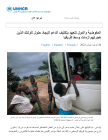Click to expand Image
A man walks past the Ostankino TV centre in Moscow, Russia on March 15, 2022.
© 2022 AFP via Getty Images
(Berlin) – Russian authorities should stop broadcasting programs featuring images of and interviews with captured Ukrainian soldiers that expose them to public curiosity, Human Rights Watch said today. Such treatment of prisoners of war, or POWs, violates protections under the Geneva Conventions intended to ensure dignified treatment of captured combatants on all sides.
“Russian authorities should stop filming Ukrainian POWs and broadcasting their images, even if they are in situations of relative comfort,” said Aisling Reidy, senior legal adviser at Human Rights Watch. “The obligation under the Geneva Conventions is to protect POWs from being objects of public curiosity, as well as from intimidation or humiliation.”
On April 2 and 4, 2022, several Russian television stations broadcast reports showing, and in many cases identifying, Ukrainian POWs in Russian custody in Sevastopol, including footage of Tatyana Moskalkova, high commissioner for human rights in the Russian Federation, alongside and interacting with the POWs. These reports appeared on the website of Channel One, the main Russian government television station in multiple places as well as the television programming of NTS, a television station in Russia-occupied Crimea. They were also shared on Facebook and Youtube. The purpose of the broadcasts appears to be to demonstrate that Russian authorities are treating POWs well.
Similarly, several videos posted in April to Zvezda, the news website of the Armed Services of the Russian Federation, show Ukrainian POWs variously praising their medical treatment, describing circumstances leading to their capture, and discussing their views about their military service. At least two of these videos appear to have been filmed in areas of Donetsk and Luhansk regions occupied by Russia.
A March 26 report by the United Nations Human Rights Monitoring Mission in Ukraine noted the existence of “a large number of videos” showing Ukrainian POWs being insulted and intimidated upon their capture. The mission also said that it had several videos showing “interrogations of POWs immediately after their capture,” carried out either by Russian armed forces or by members of armed groups affiliated with self-proclaimed “republics.” Some of the POWs appeared to have bruises, the UN mission said.
Human Rights Watch wrote to Channel One and Zvezda on April 21 to express concern about their broadcasts and to ask what steps were being taken to ensure that POWs are treated in compliance with the Geneva Conventions. As of April 28, Human Rights Watch was still awaiting a reply.
The International Committee of the Red Cross (ICRC) has made clear that any material that allows viewers or readers to identify individual prisoners should not be transmitted, published, or broadcast. There are exemptions to the prohibition, but they are allowed only if there is a compelling public interest or if exposing the materials is in the prisoner’s vital interest, and then only insofar as that respects the person’s dignity.
All authorities in charge of prisoners of war should also ensure that official personnel are not taking photos or videos of prisoners other than for official purposes, and that official images or other personal information of prisoners are stored securely. Access to this material should only be allowed for personnel directly involved in the relevant duties. The use of these materials for any other purposes is strictly prohibited.
The Russian government should ensure that the ICRC has access to all prisoners of war and should work with the it to ensure that all personal information and data on about prisoners of war is handled in accordance with the Geneva Conventions. An April 13 report published under the auspices of the Organization for Security and Co-operation in Europe expressed concern that both Russia and Ukraine had violated the Geneva Conventions by not allowing the ICRC to visit prisoners of war for at least one month at the start of the conflict.
The media should also refrain from broadcasting or republishing material concerning or showing prisoners of war that violates the laws of war, Human Rights Watch said. Social media platforms should take steps to identify and suppress access to material that violates the POWs’ right to humane treatment, including protection from public curiosity. Twitter’s decision, announced April 5, to remove Tweets posted by state-affiliated media accounts “which share media that depict prisoners of war” in the war in Ukraine was a positive move, Human Rights Watch said.
In March, Human Rights Watch reported that Ukraine’s State Security Service and Interior Ministry had posted numerous videos to their respective social media accounts depicting the humiliation and intimidation of Russian POWs. Human Rights Watch said that Ukrainian authorities should stop this practice. Human Rights Watch also said that Ukrainian authorities should investigate allegations that Ukrainian servicemen had beaten Russian POWs and shot several in the legs, as depicted in video footage and shared on social media. If verified, those responsible should be prosecuted for war crimes.
“It is vital for all warring parties to respect their obligations for humane treatment of POWs, which includes the prohibition on subjecting them to public curiosity, and to allow the ICRC access to POWs to facilitate information exchange and communication,” Reidy said. “In particular, the warring parties should prevent and punish war crimes concerning prisoners of war, such as willfully mistreating or injuring them.”



